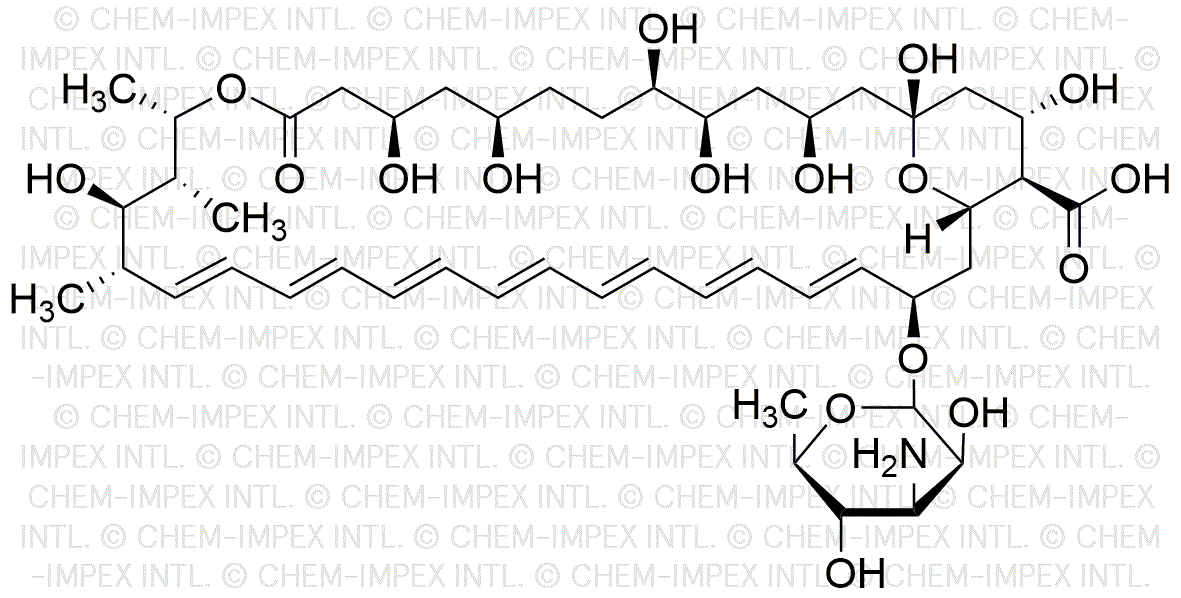Amphotericin B is widely utilized in research focused on
- Antifungal Treatment: It is primarily used to treat serious fungal infections, especially in immunocompromised patients, providing a critical option where other treatments may fail.
- Pharmaceutical Development: Researchers use it as a benchmark compound in the development of new antifungal agents, allowing for comparative studies on efficacy and safety.
- Drug Formulation: Its unique properties are leveraged in the formulation of liposomal drugs, enhancing the delivery and reducing toxicity, which is vital for patient compliance.
- Veterinary Medicine: Amphotericin B is also applied in veterinary practices to treat fungal infections in animals, ensuring broader applications in healthcare.
- Research on Drug Resistance: It serves as a key compound in studies investigating antifungal resistance mechanisms, helping to inform future therapeutic strategies.
Informations générales
Propriétés
Sécurité et réglementation
Applications
Amphotericin B is widely utilized in research focused on
- Antifungal Treatment: It is primarily used to treat serious fungal infections, especially in immunocompromised patients, providing a critical option where other treatments may fail.
- Pharmaceutical Development: Researchers use it as a benchmark compound in the development of new antifungal agents, allowing for comparative studies on efficacy and safety.
- Drug Formulation: Its unique properties are leveraged in the formulation of liposomal drugs, enhancing the delivery and reducing toxicity, which is vital for patient compliance.
- Veterinary Medicine: Amphotericin B is also applied in veterinary practices to treat fungal infections in animals, ensuring broader applications in healthcare.
- Research on Drug Resistance: It serves as a key compound in studies investigating antifungal resistance mechanisms, helping to inform future therapeutic strategies.
Documents
Fiches de données de sécurité (FDS)
La FDS fournit des informations de sécurité complètes sur la manipulation, le stockage et l’élimination du produit.
Spécifications du produit (PS)
Le PS fournit une description complète des propriétés du produit, notamment sa composition chimique, son état physique, sa pureté et les exigences de stockage. Il détaille également les plages de qualité acceptables et les applications prévues du produit.
Certificats d'analyse (COA)
Recherchez des certificats d'analyse (COA) en saisissant le numéro de lot du produit. Les numéros de lot et de lot se trouvent sur l'étiquette d'un produit, après les mots « Lot » ou « Lot de fabrication ».
Numéro de catalogue
Numéro de lot/série
Certificats d'origine (COO)
Ce certificat d'exploitation confirme le pays dans lequel le produit a été fabriqué, et détaille également les matériaux et composants utilisés et s'il est issu de sources naturelles, synthétiques ou autres sources spécifiques. Ce certificat peut être requis pour les douanes, le commerce et la conformité réglementaire.
Numéro de catalogue
Numéro de lot/série
Fiches de données de sécurité (FDS)
La FDS fournit des informations de sécurité complètes sur la manipulation, le stockage et l’élimination du produit.
DownloadSpécifications du produit (PS)
Le PS fournit une description complète des propriétés du produit, notamment sa composition chimique, son état physique, sa pureté et les exigences de stockage. Il détaille également les plages de qualité acceptables et les applications prévues du produit.
DownloadCertificats d'analyse (COA)
Recherchez des certificats d'analyse (COA) en saisissant le numéro de lot du produit. Les numéros de lot et de lot se trouvent sur l'étiquette d'un produit, après les mots « Lot » ou « Lot de fabrication ».
Numéro de catalogue
Numéro de lot/série
Certificats d'origine (COO)
Ce certificat d'exploitation confirme le pays dans lequel le produit a été fabriqué, et détaille également les matériaux et composants utilisés et s'il est issu de sources naturelles, synthétiques ou autres sources spécifiques. Ce certificat peut être requis pour les douanes, le commerce et la conformité réglementaire.


